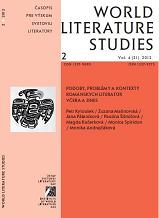Novohispánske formy synkretizmu ako interpretačný kľúč k „mexickosti“
New-Hispanic Forms of Syncreticism as an Interpretation Key to ”Mexican Identity“
Author(s): Magda KučerkováSubject(s): Literary Texts
Published by: SAV - Slovenská akadémia vied - Ústav svetovej literatúry
Keywords: Syncreticism. Mestizism. Mexican identity. Baroque. Virgin Mary of Guadalupe. Sor Juana Inés de la Cruz. Liberating spirituality.
Summary/Abstract: The article describes two forms of cultural and religious syncreticism and their artistic expression in the viceroyalty of New Spain, developed in the 17th century, where the Mexican national identity began to constitute itself. The first expression of syncreticism under survey is the Marian cult of the Virgin Mary of Guadalupe, initiated in the 16th century with the painting Our Lady of Guadalupe (Nuestra Señora de Guadalupe), while its meaning is illuminated by the 16th-century narrative Nican Mopohua, emerging from the Indian literary tradition. The study attempts to point out their connections on the level of both form and content, which inspire an interpretation of the cult from the point of view of syncretic transformations and particularly through the prism of its Mestizo essence. The second expression of syncreticism is the work of the notable Baroque author Sor Juana Inés de la Cruz, the Eucharist drama Divine Narcissus and its Prologue. The work presents an image of cultural and literary Mestizism in the wider historical context of the Creole society of new Spain, as reflected especially in the author’s tematization of America’s pre-Christian legacy and pagan mythology in conjunction with Christianity. In conclusion, the article opens space for thinking about what we call liberating spirituality, understood as the product of the co-existence of the European and indigenous American cultures. Its main idea is the liberation from neutrality and indifference and the return to a focus on the oppressed and marginalized. These are the values that draw various groups to the cult of Our Lady of Guadalupe as well as the work of Sor Juana Inés de la Cruz in the 20th century (Mexicans, Chicanos, Creoles, women, the poor, etc.).
Journal: World Literature Studies
- Issue Year: IV/2012
- Issue No: 2
- Page Range: 53-66
- Page Count: 14
- Language: Slovak

